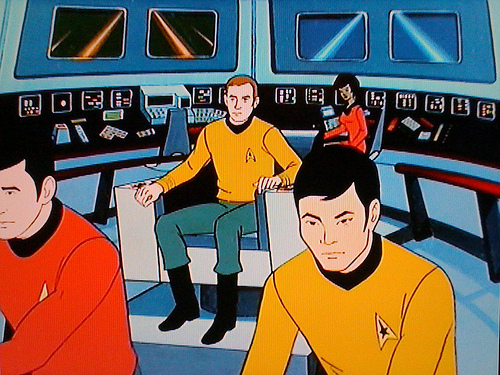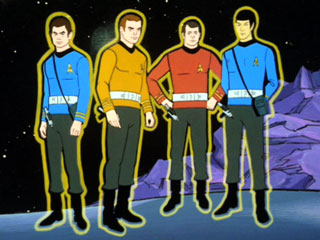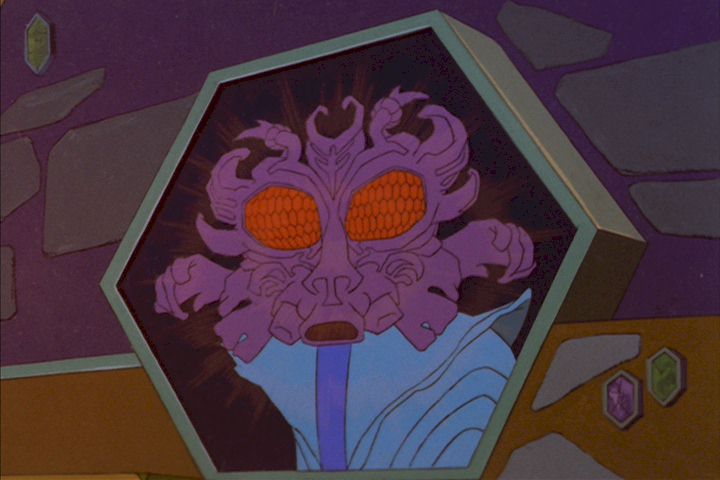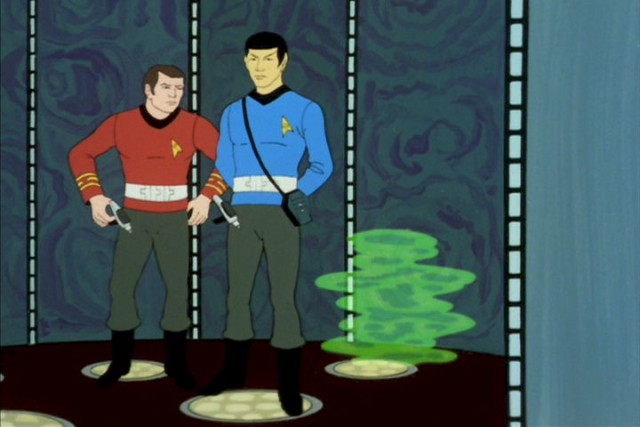
There was a brief moment this evening where I was preparing to be deeply shamed. Because I am very, very sad, I decided to watch an episode of Star Trek: The Animated Series. I have been subjected to this televisual delight before, but not for about 17 years, so I can be excused for not remembering the full tragedy of it. But at any rate, there was a point in the episode where I thought I didn’t understand it.
This would, of course, have been rather shameful. It would quite possibly have done irreparable damage to my self-esteem. To not understand an episode of Star Trek: The Animated Series is not like not understanding Spooks, for example. In Spooks I find myself regularly thinking, “What the bloody hell is going on here?” That’s not something I would expect to be thinking during an early 70s cartoon aimed at young children and those sci-fi fans who are far beyond help.
The episode in question was the first one in the series, entitled ‘Beyond the Farthest Star’, which incidentally turned out to be something of a misnomer, as the Enterprise did not travel beyond the farthest star (though in fairness, Captain Kirk did say at the end that they were going to). If I’d been in charge, I’d have called the episode ‘In Front of the Farthest Star’, though I am willing to admit this is slightly less catchy.
So basically, the Enterprise is trolling about in deep space, quite near the farthest star. In his captain’s log, Kirk says that their mission is star charting. Given they are so close to the farthest star, this is presumably not too challenging a mission, as there should be only one star to chart. Still, no one ever said the crew of the Enterprise were all that bright.

As soon as the captain’s log is over with, the red alert sirens start up and the Enterprise accelerates extremely fast towards an imploded star. Spock explains they are being drawn to the star by “hypergravity”, which the ship’s engines cannot counteract. He then mentions that they have 93 seconds before they crash, though no one looks terribly concerned about it, facial expressions apparently being beyond the ability of the animators. Kirk says something like, “Oh dear,” which seems to take him 53 seconds to do, because after that, Spock announces there’s 40 seconds to go, and starts counting down, instead of doing something useful like offering suggestions about what they could do about it. It takes Kirk to think of a way out, though it’s not all that sophisticated – “try and get into orbit of it, Mr Sulu.”
Luckily, Sulu manages to get the Enterprise into orbit of the imploded star (I’m not sure if the imploded star is the farthest star of the episode’s title or not, but even so, at no point in the episode do they go beyond this star, so my point stands). The crew then notices that there’s another ship in orbit there, which Spock says has been there for about 300 million years. Kirk decides, for no readily apparent reason, that they should beam over.

After stumping about on the outside of the ship for a while and discovering absolutely nothing, they decide to go inside, which might have been more sensible to do in the first place. On the way, they conclude that the crew of this ship destroyed it themselves – but why? Once they get inside, they find none of their equipment works anymore (though again, they don’t seem to care) and start tinkering about with a computer.

Eventually, Spock manages to make a purple and highly amusing alien appear on the screen, who says that they destroyed the ship to prevent “the malevolent life-form” from escaping. Then there’s an attempt at a sinister bit where something tries to get in through the door, and then some explosions, and then the communicators start working again with no explanation, so everyone beams back to the Enterprise again.

Unfortunately, they beam some green gas back with them. Kirk orders the transporter chief to beam the gas away again, then, without giving the chief the chance to obey the order, runs off, whacks him one, and tries to work the transporter himself. Unfortunately, he’s too late, and the gas seeps into the ship’s systems.
The episode then takes a turn for the tedious, in which the green gas turns out to be a “magnetic life form” and causes lots of the ship’s systems to stop working, including life support, necessitating another outing for the life support belts. Also, Scotty gets stuck under something or other in the engineering section, and his engineering lackeys stand around doing nothing until Kirk comes in and orders them to cut Scotty out. Honestly. It’s hardly the sort of solution that requires Mensa membership to come up with, but even Spock seemed stumped by this particular conundrum.
Then it’s the bit I initially didn’t understand. Kirk orders Sulu to make the Enterprise accelerate towards the imploded star really fast, which for some reason makes the magnetic life form flee the ship. Fortunately, it turned out that the viewer wasn’t meant to understand why – Spock helpfully explains that it left “because it thought the ship was going to crash”. Then, ignoring the “hypergravity” that got them into this mess in the first place, they fuck off towards the farthest star.
I’d like to summarise this episode and my feelings towards it with a pithy comment of the sort that’s so witty that people will be quoting it to each other for years to come and laughing till the tears roll down their cheeks. Unfortunately, I can’t think of such a comment, so instead I’ll have to settle for this: ‘Beyond the Farthest Star’ is rubbish.